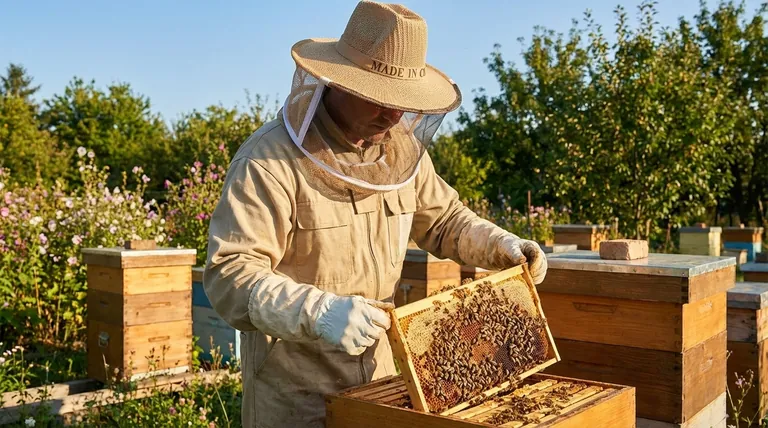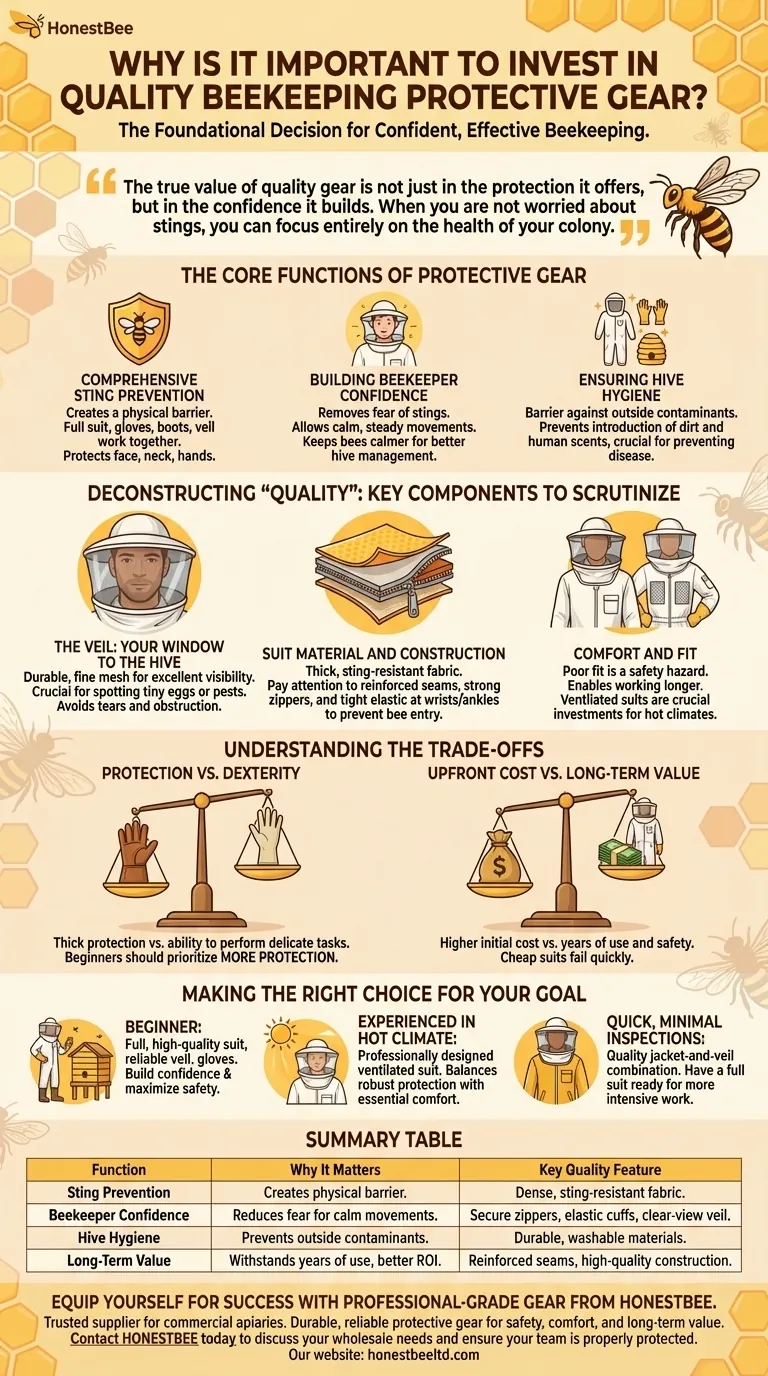Investing in quality beekeeping protective gear is the foundational decision that separates a confident, effective beekeeper from a hesitant one. It goes beyond simply avoiding stings; it ensures your safety, enhances your focus, and provides the durability needed for years of successful hive management. This investment allows you to work calmly and deliberately, which is safer for both you and your bees.
The true value of quality gear is not just in the protection it offers, but in the confidence it builds. When you are not worried about stings, you can focus entirely on the health of your colony, making you a better and more observant beekeeper.

The Core Functions of Protective Gear
Beekeeping gear serves several critical functions that are essential for the well-being of both the keeper and the hive. Understanding these functions clarifies why "good enough" is rarely sufficient.
Comprehensive Sting Prevention
The most obvious function is to create a physical barrier between you and the bees. A full suit, gloves, boots, and a veil work in concert to cover exposed skin.
This protection is paramount during hive inspections, honey harvesting, or when dealing with an agitated colony, as it prevents stings to sensitive areas like the face, neck, and hands.
Building Beekeeper Confidence
Fear and quick, jerky movements are primary triggers for defensive bee behavior. High-quality protective gear removes the fear of being stung.
This allows you to move with a calm, steady hand, which in turn keeps the bees calmer. A confident beekeeper can focus on looking for the queen, identifying pests, or assessing brood patterns without distraction.
Ensuring Hive Hygiene
Protective gear also serves as a barrier against outside contaminants. Clean suits and gloves prevent you from introducing dirt, human scents, or other materials into the hive.
Maintaining a clean apiary environment is crucial for preventing the spread of diseases that could harm the bees or compromise the quality of your honey.
Deconstructing "Quality": Key Components to Scrutinize
Not all gear is created equal. "Quality" refers to specific attributes in design and materials that have a direct impact on safety and usability.
The Veil: Your Window to the Hive
The veil is arguably the most critical piece of equipment. It protects your face and neck while allowing you to see clearly.
A quality veil uses durable, fine mesh that offers excellent visibility without sacrificing protection. Cheaper veils can obstruct your view, making it difficult to spot tiny eggs or pests, and can tear easily, creating a serious safety risk.
Suit Material and Construction
Quality suits are made from thick, sting-resistant fabric, often in multiple layers or with ventilation panels. Pay close attention to the zippers, seams, and elastic cuffs.
Weak zippers can fail or create gaps, while poorly stitched seams can unravel. Strong elastic at the wrists and ankles is essential for sealing the suit and preventing bees from crawling inside.
Comfort and Fit
A poorly fitting suit is a safety hazard. If it’s too tight, it restricts movement and pulls the fabric taut against your skin, making stings possible. If it's too loose, it can snag on equipment.
Comfort is not a luxury; it's a feature that enables you to work longer and more effectively, especially during hot weather. Ventilated suits, while more expensive, can be a crucial investment in warmer climates.
Understanding the Trade-offs
Choosing the right gear involves balancing competing priorities. Being aware of these trade-offs is the mark of an informed beekeeper.
Protection vs. Dexterity
There is a direct trade-off between the thickness of your protection and your ability to perform delicate tasks.
Thick leather gloves offer maximum sting protection but make it difficult to handle frames or a queen cage gently. Thinner goatskin or nitrile gloves improve dexterity but offer less protection. New beekeepers should always err on the side of more protection until they are comfortable.
Upfront Cost vs. Long-Term Value
High-quality gear comes with a higher initial price tag. It can be tempting to opt for a cheaper starter kit.
However, a well-made suit will withstand years of use, washing, and exposure to the elements. A cheap suit may fail after a single season, costing you more in the long run and potentially compromising your safety.
Making the Right Choice for Your Goal
Your decision should be based on your experience level, climate, and the type of beekeeping you intend to practice.
- If you are a beginner: Prioritize a full, high-quality suit with a reliable veil and gloves to build confidence and ensure maximum safety from the start.
- If you are an experienced beekeeper in a hot climate: Invest in a professionally designed ventilated suit that balances robust protection with essential comfort for long inspections.
- If your primary focus is quick, minimal inspections: A quality jacket-and-veil combination may be sufficient, but always have a full suit ready for more intensive or unpredictable hive work.
The right gear empowers you to be a calm, confident, and effective steward of your hives.
Summary Table:
| Function | Why It Matters | Key Quality Feature |
|---|---|---|
| Sting Prevention | Creates a physical barrier to protect sensitive areas. | Dense, sting-resistant fabric. |
| Beekeeper Confidence | Reduces fear, allowing for calm, deliberate movements. | Secure zippers, elastic cuffs, and a clear-view veil. |
| Hive Hygiene | Prevents the introduction of outside contaminants. | Durable, washable materials. |
| Long-Term Value | Withstands years of use, providing a better return on investment. | Reinforced seams and high-quality construction. |
Equip yourself for success with professional-grade gear from HONESTBEE.
As a trusted supplier for commercial apiaries and beekeeping equipment distributors, we understand the demands of serious beekeeping. Our wholesale-focused operations provide durable, reliable protective gear designed for safety, comfort, and long-term value.
Contact HONESTBEE today to discuss your wholesale needs and ensure your team is properly protected.
Visual Guide

Related Products
- Beekeeper Cowboy Hat and Veil for Beekeeping
- Yellow Plastic Bucket Pail Perch for Beekeeping
- Long Langstroth Style Horizontal Top Bar Hive for Wholesale
- Plastic Bee Hive Stand for Beekeeping
- Professional Dual-End Stainless Steel Hive Tool for Beekeeping
People Also Ask
- What features enhance the quality of the beekeeping veil? Choose the Right Protection for Your Apiary
- Why are a hat and veil considered the most important parts of beekeeping protective gear? Essential Protection for Your Face and Confidence
- What are the benefits of the lightweight fabric used in the beekeeping hat veil? Enhanced Visibility & Comfort for Hive Work
- How does the design of the beekeeping hat ensure comfort during extended use? Maximize Comfort for Long Apiary Hours
- Why is head protection important for beekeepers? Essential Safety for Confident Hive Management



















